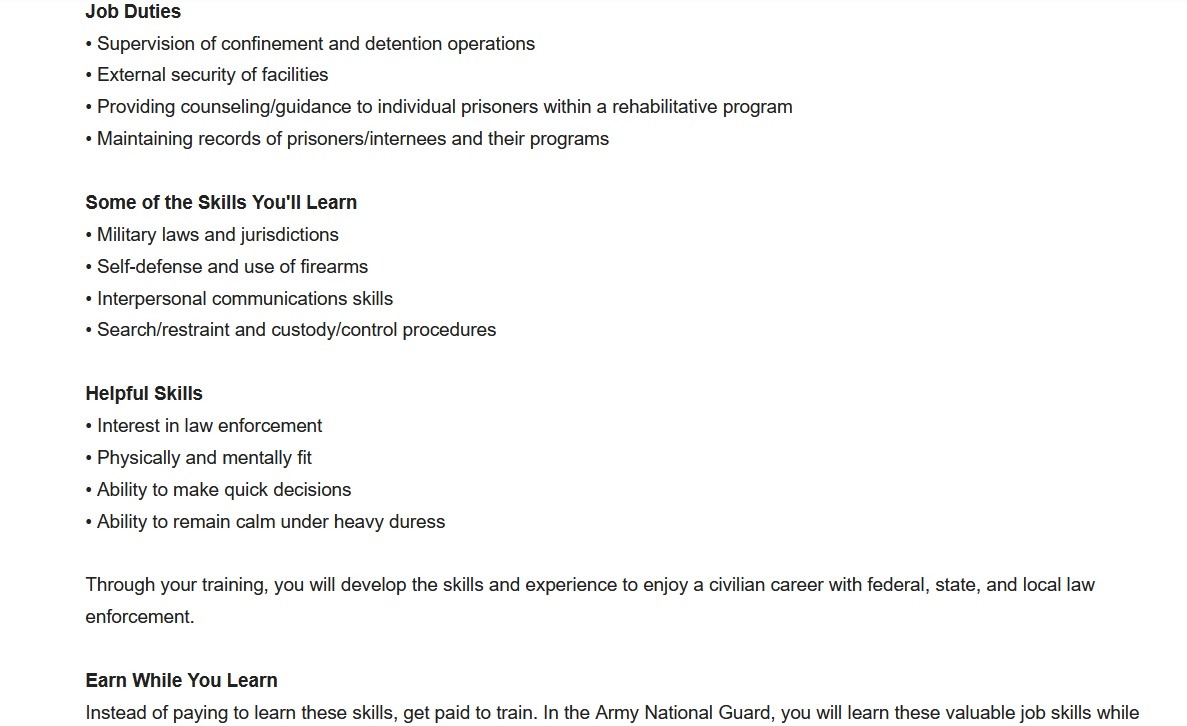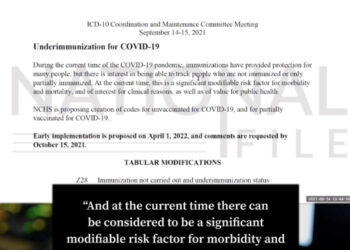Last Updated on August 13, 2021
The Army National Guard is actively recruiting for a job position called “Internment/Resettlement Specialist.” People as young as seventeen years old are eligible for the gig, which includes “Search/Restraint” as “Some of the Skills You’ll Learn,” according to an Army National Guard job posting with a job location listed as Washington, D.C. Meanwhile, military documents show that the military can detain civilians here in America, including U.S. citizens. A leaked U.S. Headquarters of the Army document entitled “INTERNMENT AND RESETTLEMENT OPERATIONS” describes an official category of detained person called “civilian internee.” A Department of Defense Directive published below discussed “civilian internees” and made it clear that military detainees can be U.S. citizens.
“In the Army National Guard, you will learn these valuable job skills while earning a regular paycheck and qualifying for tuition assistance. Job training for an Internment Resettlement Specialist requires 10 weeks of Basic Combat Training, where you’ll learn basic Soldiering skills, and seven weeks of Advanced Individual Training with on-the-job instruction. Part of this time is spent in the classroom and part of the time in the field,” states this Army National Guard job posting. Note the location for the job: Washington, D.C.


“Internment/resettlement specialists are primarily responsible for day-to-day operations in a military confinement/correctional facility or detention/internment facility,” according to an Army National Guard job posting that touts “A monthly paycheck” as a benefit to being an internment and resettlement specialist.
Department of Defense DIRECTIVE Number 2310.01E issued on August 19, 2014 states (emphasis added): “Subject to the requirements of the law of war and this directive, POWs and unprivileged belligerents may
lawfully be detained until a competent authority determines that the conflict has ended or that active hostilities have ceased, and civilian internees may lawfully be detained until the reasons that necessitated the civilian’s internment no longer exist.”
The DoD directive states that “Biometric identification information (BII) will be collected from all detainees in accordance with DoDD 8521.01E (Reference (i)) as soon as practicable after their capture by, or transfer to, the custody or control of DoD personnel, and will be included in detainee records. BII collected on detainees who are U.S. citizens or U.S. resident aliens will be conducted in accordance with U.S. law and policy and all applicable DoD regulations…Civilian internees interned for imperative reasons of security or for their protection will be transferred or released when the reasons that necessitated internment no longer exist and a safe and orderly transfer or release is practicable. A civilian internee convicted of a criminal offense will be released from punitive confinement when the court administered sentence to confinement ends.”
In the DoD directive, “civilian internee” is defined as “Any civilian, including any person described by Article 4 of Reference (e), who is in the custody or control of DoD during an armed conflict or case of occupation, such as those held for imperative reasons of security or protection.”
In the DoD directive, “detainee” is defined as “Any individual captured by, or transferred to the custody or control of, DoD personnel pursuant to the law of war. This does not include persons being held solely for law enforcement purposes, except where the United States is the occupying power. Detainees who are U.S. citizens or U.S. resident aliens will continue to enjoy all applicable rights and privileges under U.S. law and DoD regulations.”
In the DoD directive, “DoD detention facilities…Encompass all temporary holding facilities, screening facilities, and longer-term internment facilities” and the job of a position known as “GC DoD” is defined as: “Provides legal advice on detainee matters to OSD organizations and, as appropriate, other DoD Components…Coordinates with the Department of Justice and other agencies regarding detainee-related litigation matters and on matters pertaining to detainees who may be U.S. citizens, dual-nationals with U.S. citizenship, or U.S. resident aliens, as appropriate.”
In the DoD directive, “Combatant Commanders” are expected to “Report to the Secretary of Defense and the Chairman of the Joint Chiefs of Staff when capturing, detaining, or accepting custody under the law of war over any person: (1) Who may be a U.S. citizen or national, a citizen of a coalition or ally nation, or an individual under the age of 18 years.”
In the DoD directive, the term “unprivileged belligerent” is defined as “An individual who is not entitled to the distinct privileges of combatant status (e.g., combatant immunity), but who by engaging in hostilities has incurred the corresponding liabilities of combatant status. Examples of unprivileged belligerents are: Individuals who have forfeited the protections of civilian status by joining or substantially supporting an enemy non-state armed group in the conduct of hostilities. Combatants who have forfeited the privileges of combatant status by engaging in spying, sabotage, or other similar acts behind enemy lines.”
This Army document from February 2010 entitled “INTERNMENT AND RESETTLEMENT OPERATIONS” states the following (emphasis added): “Additionally, FM 3-39.40 discusses the critical issue of detainee rehabilitation. It describes the doctrinal foundation, principles, and processes that military police and other elements will employ when dealing with I/R populations. As part of internment, these populations include U.S. military prisoners, and multiple categories of detainees (civilian internees [CIs], retained personnel [RP], and enemy combatants), while resettlement operations are focused on multiple categories of dislocated civilians (DCs).”
Chapter 1 of the document describes a category of internee called a “civilian internee” referred to with the symbol “CI.” The Army document states in bold: “Internment and resettlement operations are conducted by military police to shelter, sustain, guard, protect, and account for populations (detainees, U.S. military prisoners, or dislocated civilians) as a result of military or civil conflict, natural or man-made disaster, or to facilitate criminal prosecution. Internment involves the detainment of a population or group that pose some level of threat to military operations. Resettlement involves the quartering of a population or group for their protection. These operations inherently control the movement and activities of their specific population for imperative reasons of security, safety, or intelligence gathering.” The document states that “U.S. military prisoners will be released via one of following three methods: Prisoners without discharges will be returned to their units for duty or administrative discharge proceedings after they have completed their sentence to confinement. Prisoner may be paroled (early release with conditions). Prisoners may be under mandatory, supervised release (release at the end of confinement, but with conditions tantamount to parole).”

The Army document states: “DISTRIBUTION RESTRICTION: Distribution authorized to the DOD and DOD contractors only to protect technical or operational information from automatic dissemination under the International Exchange Program or by other means. This determination was made on 8 December 2008. Other requests for this document must be referred to the Commandant, U.S. Army Military Police School, ATTN: ATZT-TDD-M, 320 MANSCEN Loop, Suite 270, Fort Leonard Wood, Missouri 65473-8929. DESTRUCTION NOTICE: Destroy by any method that will prevent disclosure of contents or reconstruction of the document.”





















